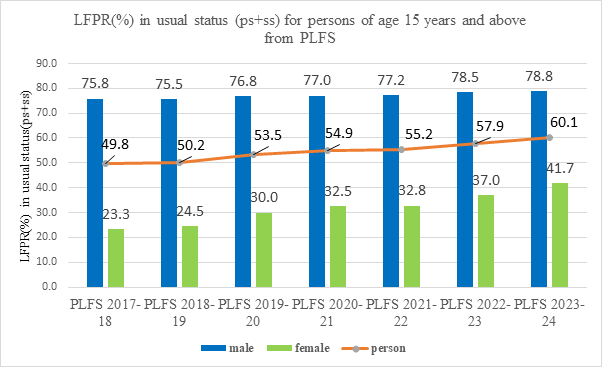PLFS REPORT 2023-24

- 26 Sep 2024
In News:
The Periodic Labour Force Survey (PLFS) conducted by the National Statistical Office (NSO) from July 2023 to June 2024 provides crucial insights into the employment landscape in India.
Key Findings from the PLFS Report 2023-24
- Labour Force Participation Rate (LFPR):
- The LFPR for individuals aged 15 years and above rose to 60.1%, an increase from 57.9% the previous year.
- For males, LFPR is at 78.8%, while for females, it increased to 41.7%, up from 37.0%.
- Worker Population Ratio (WPR):
- The WPR for the same age group stands at 58.2%. This is composed of 76.3% for males and 40.3% for females.
- Female WPR improved from 35.9% to 40.3% during the reporting period.
- Unemployment Rate (UR):
- The overall unemployment rate is 3.2%. It slightly declined for males from 3.3% to 3.2%, while it increased for females from 2.9% to 3.2%.
Overview of the PLFS
The PLFS, initiated in April 2017, aims to provide timely and accurate labor market data. It focuses on two main objectives:
- Short-term Employment Indicators: Measure key employment metrics every three months in urban areas using the Current Weekly Status (CWS) approach.
- Annual Estimates: Gather employment and unemployment data for both urban and rural areas, assessing them in terms of Usual Status and CWS.
Methodology and Sample Design
- The survey employs a rotational panel sampling design in urban areas, where households are visited multiple times to ensure comprehensive data collection.
- During the 2023-24 period, a total of 12,800 Field Sampling Units (FSUs) were designated, with 12,743 successfully surveyed.
Conceptual Framework
Key indicators measured include:
- Labour Force Participation Rate (LFPR): Percentage of the population working or actively seeking work.
- Worker Population Ratio (WPR): Percentage of employed individuals in the total population.
- Unemployment Rate (UR): Proportion of unemployed individuals among the labor force.
Challenges in Job Creation
India continues to face significant challenges in generating formal jobs. Key factors contributing to this issue include:
- Informalization of Employment: Growth in sectors like agriculture and construction is leading to increased informal employment, lacking social security and job protections.
- Technological Advancements: Automation and AI threaten job opportunities, even for skilled workers, as evidenced by layoffs in the IT sector.
- Skill Mismatch: Despite a push for skill development, the share of skilled jobs has declined, highlighting a growing disconnect between training programs and labor market needs.
- Policy Impacts: Past policies, such as demonetization and poorly implemented GST, have negatively impacted small and medium enterprises (SMEs), which are vital for job creation.
Way Forward:
To address these challenges, several strategies are proposed:
- Sectoral Diversification: Fostering investments in manufacturing, renewable energy, and technology can generate productive jobs.
- Support for MSMEs: Targeted financial aid and regulatory relief for micro, small, and medium enterprises are crucial for boosting their employment potential.
- Skill Development: Aligning training initiatives with current industry demands, particularly in emerging sectors, is essential.
- Focus on New-Age Services: Encouraging growth in sectors like e-commerce and online education could create diverse job opportunities.
Conclusion
The PLFS 2023-24 reveals an encouraging increase in labor force participation, particularly among women, while also highlighting persistent challenges in unemployment and gender disparities. The findings underscore the need for continued efforts to enhance job creation and improve employment conditions in both formal and informal sectors.
